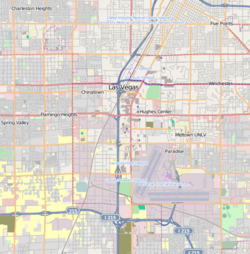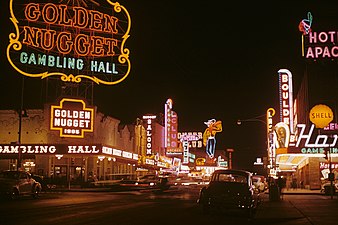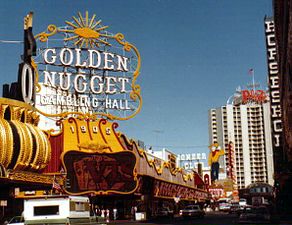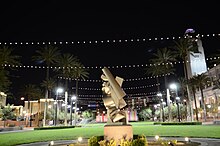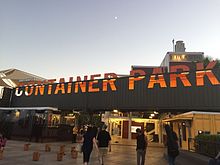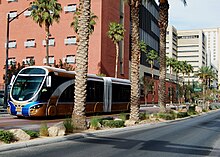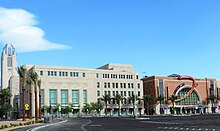
Las Vegas, often known simply as Vegas, is the most populous city in the U.S. state of Nevada and the county seat of Clark County. The Las Vegas Valley metropolitan area is the largest within the greater Mojave Desert, and second-largest in the Southwestern United States. Las Vegas is an internationally renowned major resort city, known primarily for its gambling, shopping, fine dining, entertainment, and nightlife, with most venues centered on downtown Las Vegas and more to the Las Vegas Strip just outside city limits. The Las Vegas Valley as a whole serves as the leading financial, commercial, and cultural center for Nevada. According to the United States Census Bureau, the city had 641,903 residents in 2020, with a metropolitan population of 2,227,053, making it the 25th-most populous city in the United States.

The Las Vegas Strip is a stretch of Las Vegas Boulevard in Clark County, Nevada, that is known for its concentration of resort hotels and casinos. The Strip, as it is known, is about 4.2 mi (6.8 km) long, and is immediately south of the Las Vegas city limits in the unincorporated towns of Paradise and Winchester, but is often referred to simply as "Las Vegas".

The Las Vegas Valley is a major metropolitan area in the southern part of the U.S. state of Nevada, and the second largest in the Southwestern United States. The state's largest urban agglomeration, the Las Vegas Metropolitan Statistical Area is coextensive since 2003 with Clark County, Nevada. The Valley is largely defined by the Las Vegas Valley landform, a 600 sq mi (1,600 km2) basin area surrounded by mountains to the north, south, east and west of the metropolitan area. The Valley is home to the three largest incorporated cities in Nevada: Las Vegas, Henderson and North Las Vegas. Eleven unincorporated towns governed by the Clark County government are part of the Las Vegas Township and constitute the largest community in the state of Nevada.

The Fremont Hotel & Casino is located in downtown Las Vegas, Nevada. It is part of the Fremont Street Experience, named after American explorer and politician John C. Frémont. The casino is operated by the Boyd Gaming Corporation.

The Fremont Street Experience (FSE) is a pedestrian mall and attraction in downtown Las Vegas, Nevada. The FSE occupies the westernmost five blocks of Fremont Street, including the area known for years as "Glitter Gulch", and portions of some other adjacent streets.

The Welcome to Fabulous Las Vegas sign is a Las Vegas landmark funded in May 1959 and erected soon after by Western Neon. The sign was designed by Betty Willis at the request of Ted Rogich, a local salesman, who sold it to Clark County, Nevada.
Las Vegas Boulevard is a major road in Clark County, Nevada, United States, best known for the Las Vegas Strip portion of the road and its casinos. Formerly carrying U.S. Route 91 (US 91), which had been the main highway between Los Angeles, California and Salt Lake City, Utah, it has been bypassed by Interstate 15 and serves mainly local traffic with some sections designated State Route 604.
The settlement of Las Vegas, Nevada was founded in 1905 after the opening of a railroad that linked Los Angeles and Salt Lake City. The stopover attracted some farmers to the area, and fresh water was piped in to the settlement. In 1911, the town was incorporated as part of the newly founded Clark County. Urbanization took off in 1931 when work started on the Boulder Dam, bringing a huge influx of young male workers, for whom theaters and casinos were built, largely by the Mafia. Electricity from the dam also enabled the building of many new hotels along the Strip. The arrival of Howard Hughes in 1966 did much to offset mob influence and helped turn Las Vegas into more of a family tourist center, now classified as a Mega resort.

Fremont Street is a street in downtown Las Vegas, Nevada that is the second most famous street in the Las Vegas Valley – and Nevada – besides the Las Vegas Strip. Named in honor of explorer and politician, and coordinator of the Sacramento River massacre John C. Frémont and located in the heart of the downtown casino corridor, Fremont Street is today, or was, the address for many famous casinos such as Binion's Horseshoe, Eldorado Club, Fremont Hotel and Casino, Golden Gate Hotel and Casino, Golden Nugget, Four Queens, The Mint, and the Pioneer Club.
The Silver Slipper was a casino in Paradise, Nevada, that operated from September 1950 to November 29, 1988. The building was designed by architect Martin Stern, Jr.

The Plaza Hotel & Casino is a hotel and casino located in downtown Las Vegas, Nevada. It currently has 995 rooms and suites, an 80,000-square-foot (7,400 m2) casino and more than 25,000 square feet (2,300 m2) of event space. The Plaza also features a showroom, rooftop swimming pool, fitness center, bingo room, multiple dining outlets, a sports book, and Oscar's Steakhouse, named after the former Mayor of Las Vegas, Oscar Goodman.

The Neon Museum in Las Vegas, Nevada, United States, features signs from old casinos and other businesses displayed outdoors on 2.62 acres (1.06 ha). The museum features a restored lobby shell from the defunct La Concha Motel as its visitors' center, which officially opened on October 27, 2012.

Vegas Vic is a neon sign portraying a cowboy which was erected on the exterior of The Pioneer Club in Las Vegas, Nevada, USA in 1951. The sign was a departure in graphic design from typeface based neon signs, to the friendly and welcoming human form of a cowboy. The sign's human-like abilities of talking and waving its arm received an immediate acceptance as the unofficial welcoming sign, reproduced thousands of times over the years and all over the world. The sign can still be found at 25 E Fremont Street, where it has been since 1951 on the exterior of what used to be The Pioneer Club but is currently a souvenir shop. The trademark is currently owned by Pioneer Hotel, Inc., which owns and operates the Pioneer Hotel and Gambling Hall on the Colorado River in Laughlin, Nevada. Laughlin has a twin of the Vegas Vic image on another large sign referred to as River Rick.
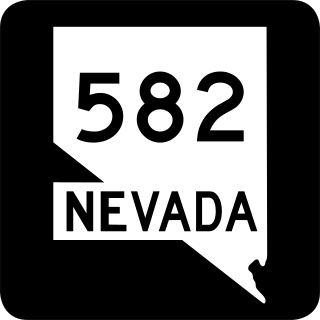
State Route 582 (SR 582) is a major 15.392-mile-long (24.771 km) highway in the Las Vegas Valley. The highway is the former route of U.S. Route 93 (US 93) and US 95 before they were moved to the current freeway alignment shared with Interstate 11 (I-11) and Interstate 515 (I-515). Known primarily as Boulder Highway, the route connects Downtown Las Vegas with Henderson and Boulder City to the southeast.

Pioneer Club Las Vegas was a casino that opened in 1942 and was located in Downtown Las Vegas, Nevada, at 25 East Fremont Street. It ceased operating as a casino in 1995, the same year the Fremont Street Experience was completed.

"Downtown Las Vegas Area" is the name assigned by the Nevada Gaming Control Board (NGCB) which includes the Downtown Las Vegas area casinos and the Stratosphere Tower which is located 2 miles (3.2 km) from Fremont Street. The city of Las Vegas uses the term Downtown Gaming for the casinos near the Fremont Street Experience. The land is part of the 110 acres (45 ha) that were auctioned on May 15, 1905 when the city was founded.

The Las Vegas Arts District, or the 18b in Downtown Las Vegas, Nevada was created in 1998 as an 18 block zone set aside to encourage art and artists.

The 1950s was a time of considerable change for Las Vegas. By the 1950s, there were 44,600 living in the Las Vegas Valley. Over 8 million people were visiting Las Vegas annually in 1954, pumping $200 million into casinos, which consolidated its image as "wild, full of late-night, exotic entertainment". The population grew dramatically from 8,422 during World War II to over 45,000. From 1952 to 1957, through money and institutional lending provided by the Teamsters Union and some Mormon bankers, they built the Sahara, the Sands, the New Frontier, the Royal Nevada, the Showboat, the Riviera, the Fremont, Binion's Horseshoe, and finally the Tropicana. Gambling was no longer the only attraction by the 1950s; the biggest stars of films and music like Frank Sinatra, Dean Martin, Sammy Davis, Jr., Peter Lawford, Andy Williams, Liberace, Bing Crosby, Carol Channing, and others performed in intimate settings and brought a whole new brigade of Hollywood film stars and others in the entertainment business to the city. In 1957, the first topless show "Minsky's Follies" was started here.
The following is a timeline of the history of the city of Las Vegas, Nevada, United States.

James Stanford is an American contemporary artist, photographer, and book publisher based in Las Vegas, Nevada. He is best known for his contemporary work inspired by vintage and historical Las Vegas marquees and signage and also for his leadership in the development of the Las Vegas arts community. Stanford is a Buddhist and his practice draws heavily on the principles and philosophies of Zen Buddhism.


